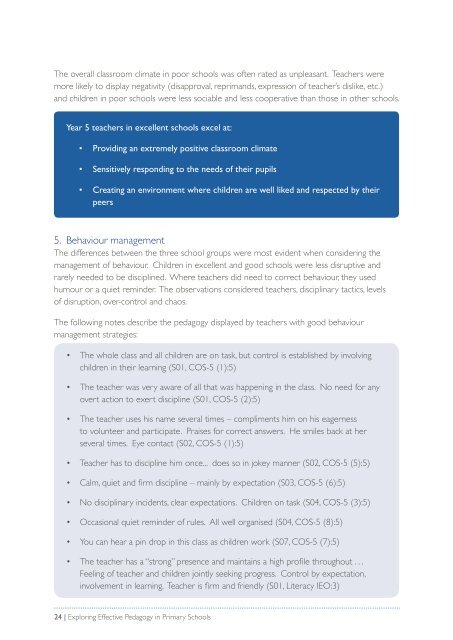Pearson-Exploring-Effective-Pedagogy-in-Primary-Schools
Pearson-Exploring-Effective-Pedagogy-in-Primary-Schools
Pearson-Exploring-Effective-Pedagogy-in-Primary-Schools
Create successful ePaper yourself
Turn your PDF publications into a flip-book with our unique Google optimized e-Paper software.
The overall classroom climate <strong>in</strong> poor schools was often rated as unpleasant. Teachers weremore likely to display negativity (disapproval, reprimands, expression of teacher’s dislike, etc.)and children <strong>in</strong> poor schools were less sociable and less cooperative than those <strong>in</strong> other schools.Year 5 teachers <strong>in</strong> excellent schools excel at:• Provid<strong>in</strong>g an extremely positive classroom climate• Sensitively respond<strong>in</strong>g to the needs of their pupils• Creat<strong>in</strong>g an environment where children are well liked and respected by theirpeers5. Behaviour managementThe differences between the three school groups were most evident when consider<strong>in</strong>g themanagement of behaviour. Children <strong>in</strong> excellent and good schools were less disruptive andrarely needed to be discipl<strong>in</strong>ed. Where teachers did need to correct behaviour, they usedhumour or a quiet rem<strong>in</strong>der. The observations considered teachers, discipl<strong>in</strong>ary tactics, levelsof disruption, over-control and chaos.The follow<strong>in</strong>g notes describe the pedagogy displayed by teachers with good behaviourmanagement strategies:• The whole class and all children are on task, but control is established by <strong>in</strong>volv<strong>in</strong>gchildren <strong>in</strong> their learn<strong>in</strong>g (S01, COS-5 (1):5)• The teacher was very aware of all that was happen<strong>in</strong>g <strong>in</strong> the class. No need for anyovert action to exert discipl<strong>in</strong>e (S01, COS-5 (2):5)• The teacher uses his name several times – compliments him on his eagernessto volunteer and participate. Praises for correct answers. He smiles back at herseveral times. Eye contact (S02, COS-5 (1):5)• Teacher has to discipl<strong>in</strong>e him once... does so <strong>in</strong> jokey manner (S02, COS-5 (5):5)• Calm, quiet and firm discipl<strong>in</strong>e – ma<strong>in</strong>ly by expectation (S03, COS-5 (6):5)• No discipl<strong>in</strong>ary <strong>in</strong>cidents, clear expectations. Children on task (S04, COS-5 (3):5)• Occasional quiet rem<strong>in</strong>der of rules. All well organised (S04, COS-5 (8):5)• You can hear a p<strong>in</strong> drop <strong>in</strong> this class as children work (S07, COS-5 (7):5)• The teacher has a “strong” presence and ma<strong>in</strong>ta<strong>in</strong>s a high profile throughout . . .Feel<strong>in</strong>g of teacher and children jo<strong>in</strong>tly seek<strong>in</strong>g progress. Control by expectation,<strong>in</strong>volvement <strong>in</strong> learn<strong>in</strong>g. Teacher is firm and friendly (S01, Literacy IEO:3)24 | <strong>Explor<strong>in</strong>g</strong> <strong>Effective</strong> <strong>Pedagogy</strong> <strong>in</strong> <strong>Primary</strong> <strong>Schools</strong>


